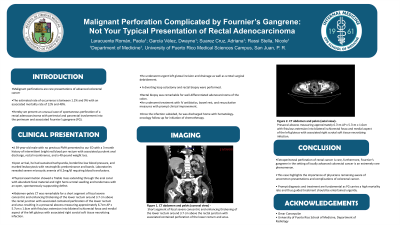Sunday Poster Session
Category: Colon
P0243 - Malignant Perforation Complicated by Fournier’s Gangrene: Not Your Typical Presentation of Rectal Adenocarcinoma
Sunday, October 22, 2023
3:30 PM - 7:00 PM PT
Location: Exhibit Hall

Has Audio

Paola Laracuente Roman, MD
University of Puerto Rico, Medical Sciences Campus
San Juan, Puerto Rico
Presenting Author(s)
Paola Laracuente-Román, MD1, Dwayne García-Vélez, MD2, Adriana Suarez-Cruz, MD2, Nicole Rassi-Stella, MD2
1University of Puerto Rico, Medical Sciences Campus, San Juan, Puerto Rico; 2University of Puerto Rico, San Juan, Puerto Rico
Introduction: Malignant perforations are rare presentations of advanced colorectal cancer. The estimated rate of occurrence is between 1.2% and 9% with an associated mortality rate of 12% and 48%. Hereby we present an unusual case of spontaneous perforation of a rectal adenocarcinoma with perirectal and pararectal involvement into the perineum and associated Fournier’s gangrene (FG).
Case Description/Methods: A 59-year-old male with no previous PMH presented to our ED with a 3-month history of intermittent bright red blood per rectum with associated purulent anal discharge, rectal incontinence, and a 40-pound weight loss. Upon arrival, he had sustained tachycardia, borderline low blood pressure, and marked leukocytosis with neutrophilic predominance and bands. Laboratories revealed severe microcytic anemia of 6.2mg/dl requiring blood transfusions. Physical examination showed a friable mass extending through the anal canal with abundant fecal material and right hemi-scrotal swelling and tenderness with an open, spontaneously suppurating defect. Abdomen-pelvis CT was remarkable for a short segment of focal severe concentric and enhancing thickening of the lower rectum around 3.7 cm above the rectal junction with associated contained perforation of the lower rectum and anus resulting in a presacral abscess measuring approximately 6.7cm AP x 5.7cm x 1.6cm with fistulous extension into bilateral ischiorectal fossa and medial aspect of the left gluteus with associated right scrotal soft tissue necrotizing infection. He underwent urgent left gluteal incision and drainage as well as scrotal surgical debridement. A diverting loop colostomy and rectal biopsy were performed. Rectal biopsy was remarkable for well-differentiated adenocarcinoma of the colon. He underwent treatment with IV antibiotics, bowel rest, and resuscitative measures with prompt clinical improvement. Once the infection subsided, he was discharged home with hematology-oncology follow-up for initiation of chemotherapy.
Discussion: Extraperitoneal perforation of rectal cancer is rare, furthermore, Fournier’s gangrene in the setting of locally advanced colorectal cancer is an extremely rare phenomenon. This case highlights the importance of physicians remaining aware of uncommon presentations and complications of colorectal cancer. Prompt diagnosis and treatment are fundamental as FG carries a high mortality rate and thus guided treatment should be entertained urgently.
Disclosures:
Paola Laracuente-Román, MD1, Dwayne García-Vélez, MD2, Adriana Suarez-Cruz, MD2, Nicole Rassi-Stella, MD2. P0243 - Malignant Perforation Complicated by Fournier’s Gangrene: Not Your Typical Presentation of Rectal Adenocarcinoma, ACG 2023 Annual Scientific Meeting Abstracts. Vancouver, BC, Canada: American College of Gastroenterology.
1University of Puerto Rico, Medical Sciences Campus, San Juan, Puerto Rico; 2University of Puerto Rico, San Juan, Puerto Rico
Introduction: Malignant perforations are rare presentations of advanced colorectal cancer. The estimated rate of occurrence is between 1.2% and 9% with an associated mortality rate of 12% and 48%. Hereby we present an unusual case of spontaneous perforation of a rectal adenocarcinoma with perirectal and pararectal involvement into the perineum and associated Fournier’s gangrene (FG).
Case Description/Methods: A 59-year-old male with no previous PMH presented to our ED with a 3-month history of intermittent bright red blood per rectum with associated purulent anal discharge, rectal incontinence, and a 40-pound weight loss. Upon arrival, he had sustained tachycardia, borderline low blood pressure, and marked leukocytosis with neutrophilic predominance and bands. Laboratories revealed severe microcytic anemia of 6.2mg/dl requiring blood transfusions. Physical examination showed a friable mass extending through the anal canal with abundant fecal material and right hemi-scrotal swelling and tenderness with an open, spontaneously suppurating defect. Abdomen-pelvis CT was remarkable for a short segment of focal severe concentric and enhancing thickening of the lower rectum around 3.7 cm above the rectal junction with associated contained perforation of the lower rectum and anus resulting in a presacral abscess measuring approximately 6.7cm AP x 5.7cm x 1.6cm with fistulous extension into bilateral ischiorectal fossa and medial aspect of the left gluteus with associated right scrotal soft tissue necrotizing infection. He underwent urgent left gluteal incision and drainage as well as scrotal surgical debridement. A diverting loop colostomy and rectal biopsy were performed. Rectal biopsy was remarkable for well-differentiated adenocarcinoma of the colon. He underwent treatment with IV antibiotics, bowel rest, and resuscitative measures with prompt clinical improvement. Once the infection subsided, he was discharged home with hematology-oncology follow-up for initiation of chemotherapy.
Discussion: Extraperitoneal perforation of rectal cancer is rare, furthermore, Fournier’s gangrene in the setting of locally advanced colorectal cancer is an extremely rare phenomenon. This case highlights the importance of physicians remaining aware of uncommon presentations and complications of colorectal cancer. Prompt diagnosis and treatment are fundamental as FG carries a high mortality rate and thus guided treatment should be entertained urgently.
Disclosures:
Paola Laracuente-Román indicated no relevant financial relationships.
Dwayne García-Vélez indicated no relevant financial relationships.
Adriana Suarez-Cruz indicated no relevant financial relationships.
Nicole Rassi-Stella indicated no relevant financial relationships.
Paola Laracuente-Román, MD1, Dwayne García-Vélez, MD2, Adriana Suarez-Cruz, MD2, Nicole Rassi-Stella, MD2. P0243 - Malignant Perforation Complicated by Fournier’s Gangrene: Not Your Typical Presentation of Rectal Adenocarcinoma, ACG 2023 Annual Scientific Meeting Abstracts. Vancouver, BC, Canada: American College of Gastroenterology.
